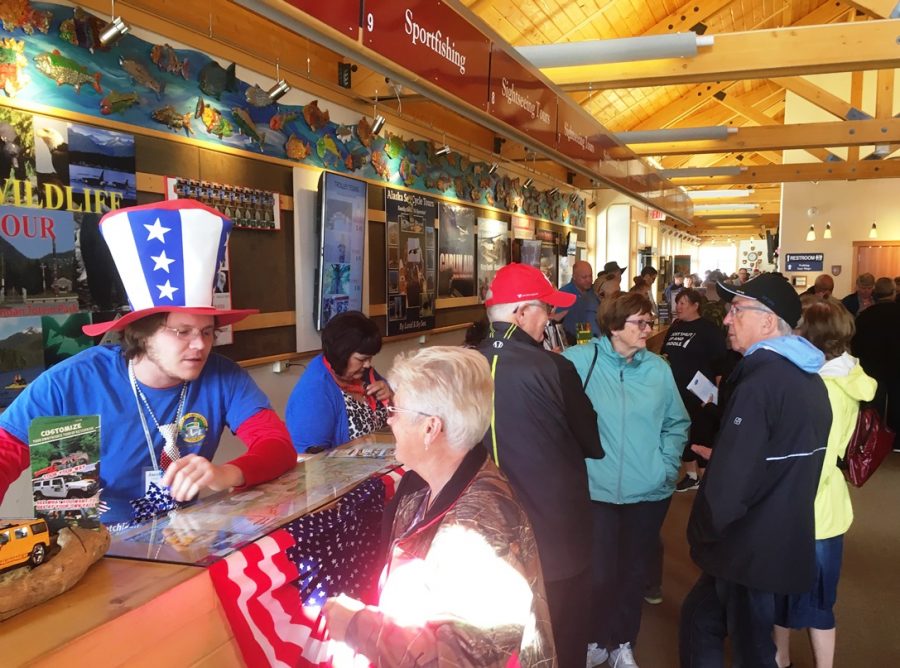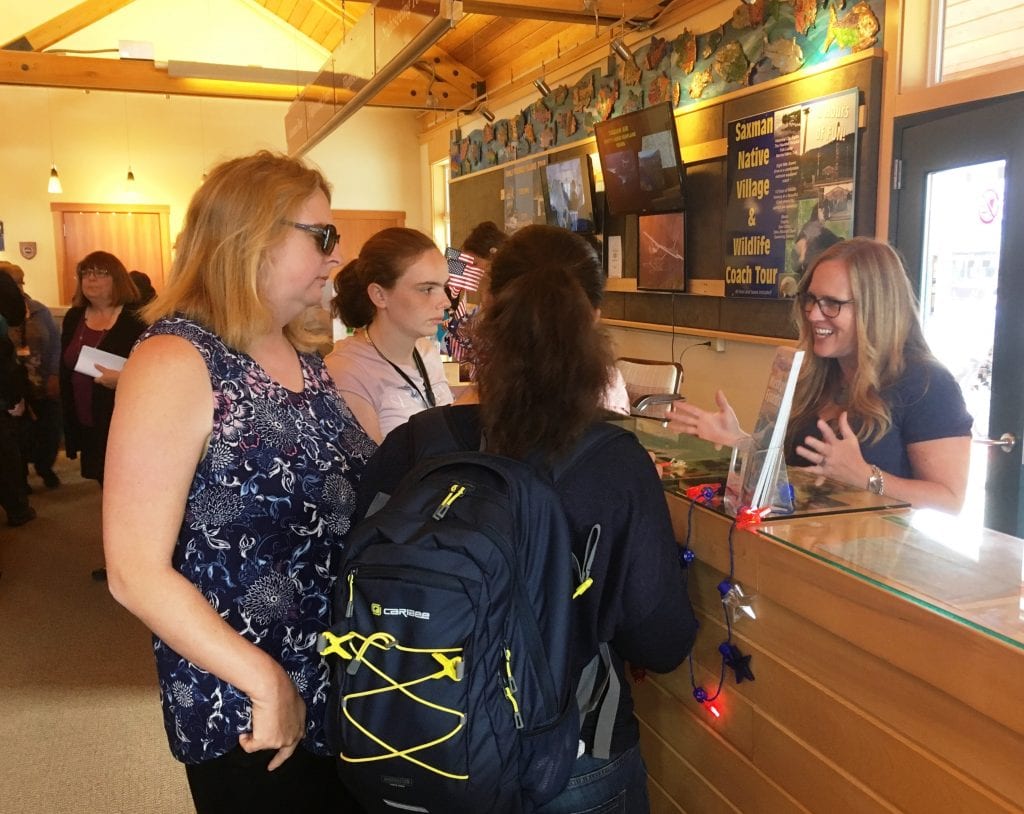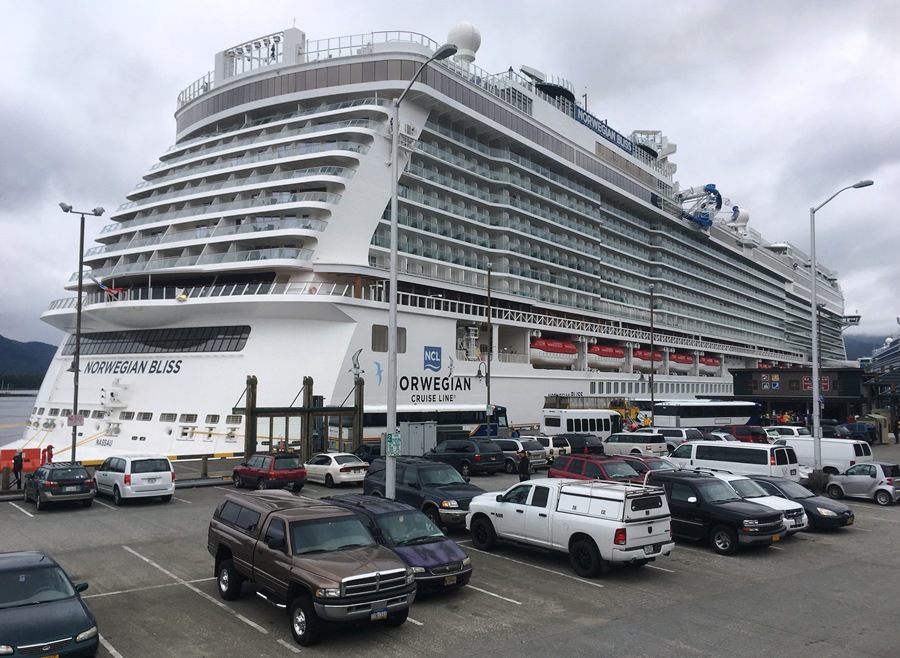
Cruise visitors wait in line at the Ketchikan Visitors’ Bureau building to buy shore excursions. (KRBD photo by Leila Kheiry)
Southeast Alaska cities have invested a lot of energy, money and infrastructure into supporting the Alaska tourism industry. What do the communities get in return?
With bigger and bigger cruise ships bringing more and more passengers to the Inside Passage, we took a look at how Southeast in general, and Ketchikan specifically, benefit from all those people.
It’s Monday. That’s when the new mega-cruise ship Norwegian Bliss docks in Ketchikan, bringing 4,000 passengers – about double the number a regular ship can hold.
Combine that with other ships in port on a typical Monday, and the community of Ketchikan’s population pretty much doubles that day throughout the tour season.
At the Ketchikan Visitors Bureau building, vendors stand behind a counter, fielding questions and – most important – selling tours to the thousands of visitors streaming through.
Loren McCue sells helicopter tours. She says Mondays are crazy.
“The Bliss is so enormous,” she said. “There’s not enough tours and things to do. They line up. It’s like a feeding frenzy.”
And, she says, the city’s infrastructure isn’t set up yet for that many people. So what will it be like when more of those huge ships start coming regularly?

Loren McCue sells helicopter tours to cruise passengers at the Ketchikan Visitors Bureau building. (KRBD photo by Leila Kheiry)
“I think they really have to rethink restrooms, traffic,” she said. “There’s a lot of issues that come along with it.”
And city officials are working with consultants on a multi-million-dollar project to reconfigure not only the docks to allow for bigger ships, but the uplands, to accommodate more people.
It’s a tough balance for a community of roughly 14,000 year-round residents. But, McCue says, those big ships will be an economic boon.
“It’s a gold mine, the Mondays,” she said. “We say that we’ve been Bliss-tered.”
Visitors Bureau Executive Director Patti Mackey was there that Monday. She brought along information from a recently released McDowell Group report on the Alaska tourism industry and its economic impact for Ketchikan.
She says total spending in Ketchikan by the industry, including all visitors, cruise ships and crew members, is about $223 million a year.
“That’s a big number. $187 million of that, so the vast majority, really is visitor spending,” she said. “That’s on things like shopping, tours, food and beverage, and transportation.”
Mackey says all that spending benefits not only the businesses, but the community in general through sales-tax revenue.
“The amount that (visitors pay), according to our research, is about 25 percent of what’s collected each year,” she said. “So if you’re paying 6.5 percent sales tax right now, you’d probably be looking at paying over 8 percent if you didn’t have that revenue being generated by our visitors.”
Mackey hears the complaints about tourism, the related congestion and the amount spent on port improvements, but says she believes most people in Ketchikan understand tourism has been good for the local economy.
And, she says, port improvements are funded through head taxes and wharfage fees paid by the cruise lines.
Mackey adds that 90 percent of tourism businesses in Ketchikan are locally owned, or at least Alaska-owned, and tourism-related jobs have gone up in recent years.
Meilani Schijvens runs Juneau-based research firm Rain Coast Data. She produces the annual Southeast By The Numbers report for Southeast Conference, and says last year’s report had one number that really surprised her: For the first time, the visitor industry was No. 1 in terms of private-sector wages in Southeast.
That’s not because they’re paid particularly well.
“It’s really among the lowest of all sectors in terms of wages,” she said. “So you need a lot of visitor industry jobs to create that level of wages that’s now being provided in the region.”
The average annual income for workers in all industries across Southeast Alaska is close to $50,000. The average wage for someone in tourism is just under $30,000.
Schijvens recently completed a business-climate survey of Southeast industries, and says the visitor industry shows the highest level of confidence — for good reason: tourism is expected to keep growing, with an estimated 1.3 million cruise passengers visiting Alaska next summer – that’s about 12 percent more than this year.
The big challenge, Schijvens says, is to make sure Southeast communities are ready for that number.
Shauna Lee’s year-round job is all about getting ready for visitors. She runs the Bering Sea Crab Fishermen’s boat tour in Ketchikan. The whole process that ends with a successful excursion starts with the cruise ship schedule, released about two years in advance.
Lee works with the cruise lines to determine how many spots each ship can sell on board, and works with visitors who purchase directly from the business. She says Ketchikan offers plenty of options for shore excursions, and many of those tours hire locally.
“I hear a lot of people say, ‘Well, the money just leaves town at the end of the year,’” she said. “Well, it’s not. Because it’s paying my mortgage. It’s paying for the mortgage of other people who work here, who live here in Ketchikan.”
Lee says other members of her family work in tourism, too. And when they buy groceries or donate to a local nonprofit, those are tourism dollars supporting the community.
Passengers start arriving, and Lee gets to work, checking in eager visitors, excited about the tour. Once they’re all on board, Lee casts the boat’s lines and they’re off.
Just like that, a two-year process is completed. Now, on to the next one.
Another regular complaint is about cruise ship discharge. Below is a link to a story we did last year on that topic.
https://www.krbd.org/2017/09/22/close-look-advanced-cruise-wastewater-system/










